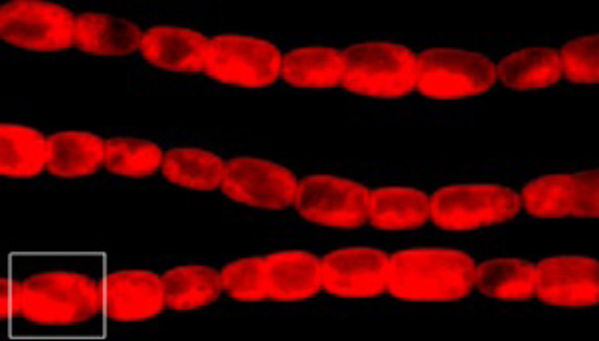Genetic Regulation of Differentiated Microbial Filaments
Discovering how a microbe makes complex structures to perform complex functions.

The Science
Discovery of genetic mechanisms in the microbe Nostoc enabling it to form “differentiated” filaments that separate and optimize photosynthesis and nitrogen fixation.
The Impact
The results of this study provide valuable new insights into the mechanisms used by microbes to tune their functional attributes through the use of structural patterns and could lead to the development of new tools for optimizing processes in biological systems engineered for bioenergy applications.
Summary
In comparison to multicellular plants and animals, bacteria are relatively simple, typically existing as single cells. However, some bacteria cooperate to form surprisingly sophisticated structures. The photosynthetic microbe Nostoc punctiforme forms long filaments of connected cells. At regular spacing along these filaments, individual cells differentiate to form heterocysts, non-photosynthetic cells that convert nitrogen gas into biologically useful nitrogen compounds. This patterning allows these microbes to separately perform both photosynthesis (which produces O2 as byproduct) and “fix” nitrogen using enzymes that are poisoned by oxygen, cooperatively exchanging the resulting nutrients between the cell types. In a new study, DOE researchers at the University of California, Davis describe genetic mechanisms responsible for the establishment and maintenance of this distinctive pattern in growing filaments. When the expression of a series of regulatory genes (the “pat system”) was experimentally manipulated, filaments formed with abnormal distributions of heterocysts. By analyzing these patterns and tracking the distribution of related proteins in dividing cells, the investigators were able to develop a new model describing the regulatory interactions resulting in the pattern that allows optimal photosynthesis and nitrogen fixation in the filaments.
Contact
Dr. John Meeks
University of California at Davis
jcmeeks@ucdavis.edu
Funding
DOE Office of Science Biological and Environmental Research (BER) program
Publications
D.D. Risser, F.C. Y. Wong, and J.C. Meeks. 2012 “Biased inheritance of the protein PatN frees vegetative cells to initiate patterned heterocyst differentiation” PNAS 109 15342-15347 (2012).
Highlight Categories
Performer: University



